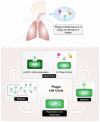The promise of bacteriophage therapy for Burkholderia cepacia complex respiratory infections
- PMID: 22919592
- PMCID: PMC3417384
- DOI: 10.3389/fcimb.2011.00027
The promise of bacteriophage therapy for Burkholderia cepacia complex respiratory infections
Abstract
In recent times, increased attention has been given to evaluating the efficacy of phage therapy, especially in scenarios where the bacterial infectious agent of interest is highly antibiotic resistant. In this regard, phage therapy is especially applicable to infections caused by the Burkholderia cepacia complex (BCC) since members of the BCC are antibiotic pan-resistant. Current studies in BCC phage therapy are unique from many other avenues of phage therapy research in that the investigation is not only comprised of phage isolation, in vitro phage characterization and assessment of in vivo infection model efficacy, but also adapting aerosol drug delivery techniques to aerosol phage formulation delivery and storage.
Keywords: Burkholderia; Burkholderia cepacia complex; aerosols; animal infection models; bacteriophage; dry powder inhalers; lung infections; phage therapy.
Figures

Similar articles
-
Advances in Phage Therapy: Targeting the Burkholderia cepacia Complex.Viruses. 2021 Jul 9;13(7):1331. doi: 10.3390/v13071331. Viruses. 2021. PMID: 34372537 Free PMC article. Review.
-
Aerosol phage therapy efficacy in Burkholderia cepacia complex respiratory infections.Antimicrob Agents Chemother. 2014 Jul;58(7):4005-13. doi: 10.1128/AAC.02388-13. Epub 2014 May 5. Antimicrob Agents Chemother. 2014. PMID: 24798268 Free PMC article.
-
Experimental bacteriophage therapy increases survival of Galleria mellonella larvae infected with clinically relevant strains of the Burkholderia cepacia complex.Antimicrob Agents Chemother. 2009 May;53(5):2205-8. doi: 10.1128/AAC.01166-08. Epub 2009 Feb 17. Antimicrob Agents Chemother. 2009. PMID: 19223640 Free PMC article.
-
In vitro lung delivery of bacteriophages KS4-M and ΦKZ using dry powder inhalers for treatment of Burkholderia cepacia complex and Pseudomonas aeruginosa infections in cystic fibrosis.J Appl Microbiol. 2011 Jan;110(1):106-17. doi: 10.1111/j.1365-2672.2010.04863.x. Epub 2010 Sep 28. J Appl Microbiol. 2011. PMID: 20875034
-
Inhaled Delivery of Anti-Pseudomonal Phages to Tackle Respiratory Infections Caused by Superbugs.J Aerosol Med Pulm Drug Deliv. 2022 Apr;35(2):73-82. doi: 10.1089/jamp.2021.0045. Epub 2021 Dec 30. J Aerosol Med Pulm Drug Deliv. 2022. PMID: 34967686 Free PMC article. Review.
Cited by
-
Burkholderia Phages and Control of Burkholderia-Associated Human, Animal, and Plant Diseases.Microorganisms. 2025 Aug 11;13(8):1873. doi: 10.3390/microorganisms13081873. Microorganisms. 2025. PMID: 40871377 Free PMC article. Review.
-
Phage therapy: breathing new tactics into lower respiratory tract infection treatments.Eur Respir Rev. 2024 Jun 26;33(172):240029. doi: 10.1183/16000617.0029-2024. Print 2024 Apr. Eur Respir Rev. 2024. PMID: 38925791 Free PMC article. Review.
-
Comparative analysis of two phenotypically-similar but genomically-distinct Burkholderia cenocepacia-specific bacteriophages.BMC Genomics. 2012 Jun 7;13:223. doi: 10.1186/1471-2164-13-223. BMC Genomics. 2012. PMID: 22676492 Free PMC article.
-
The isolation and characterization of two Stenotrophomonas maltophilia bacteriophages capable of cross-taxonomic order infectivity.BMC Genomics. 2015 Sep 3;16(1):664. doi: 10.1186/s12864-015-1848-y. BMC Genomics. 2015. PMID: 26335566 Free PMC article.
-
Advances in Phage Therapy: Targeting the Burkholderia cepacia Complex.Viruses. 2021 Jul 9;13(7):1331. doi: 10.3390/v13071331. Viruses. 2021. PMID: 34372537 Free PMC article. Review.
References
-
- AmpliPhi (2011). Product Pipeline. Available at: http://www.ampliphibio.com/index.php/pipeline/product_pipeline [accessed December 4, 2011].
Publication types
MeSH terms
Substances
Grants and funding
LinkOut - more resources
Full Text Sources
Molecular Biology Databases

